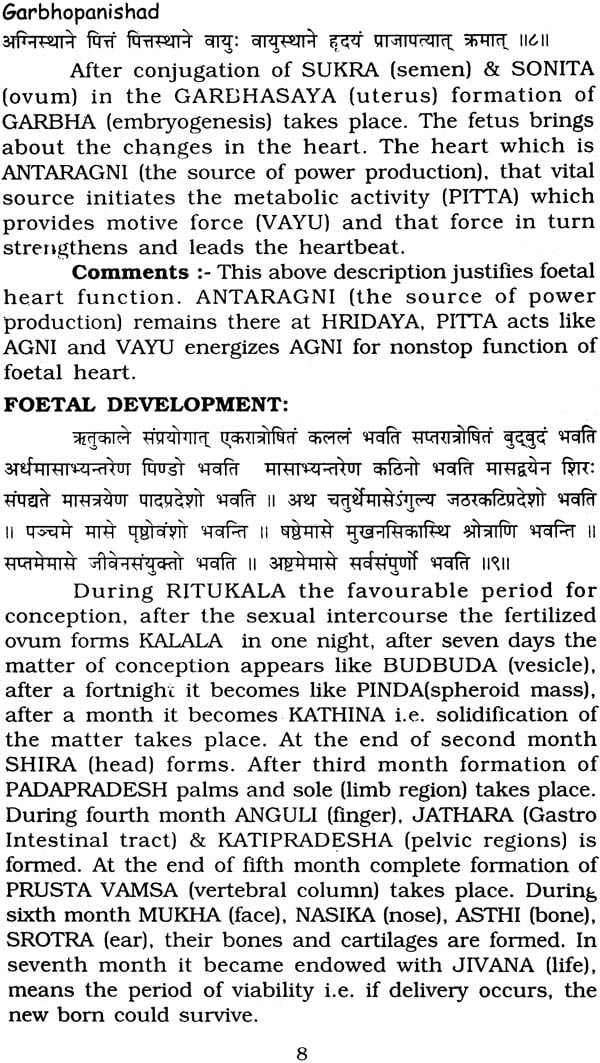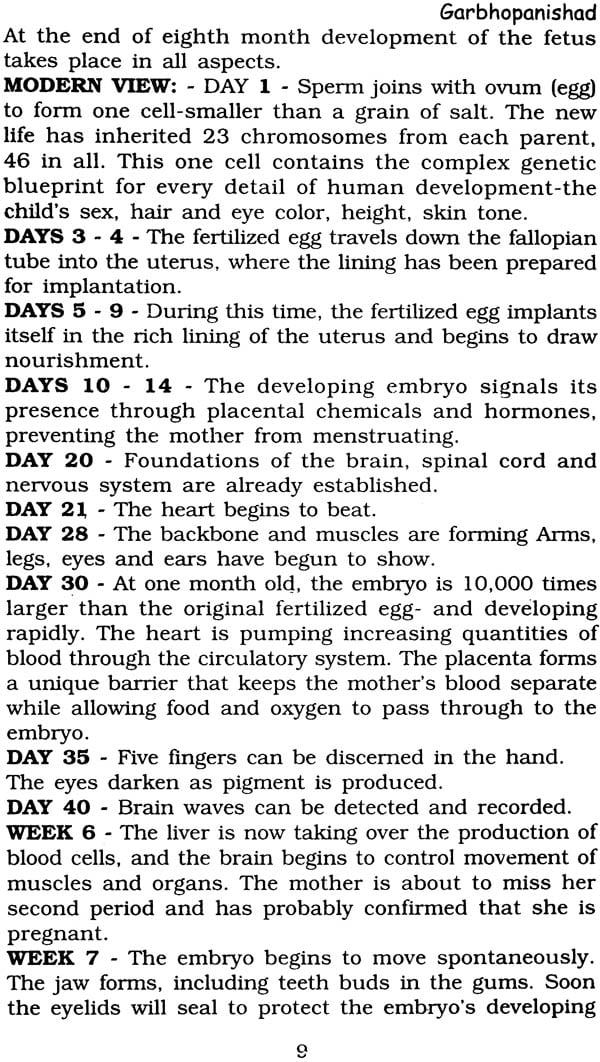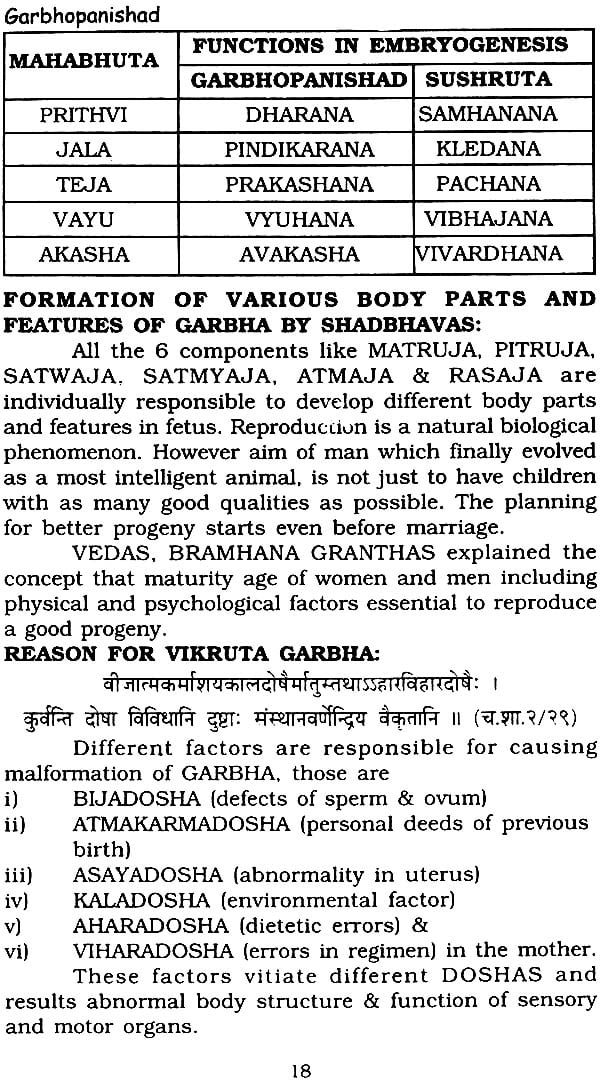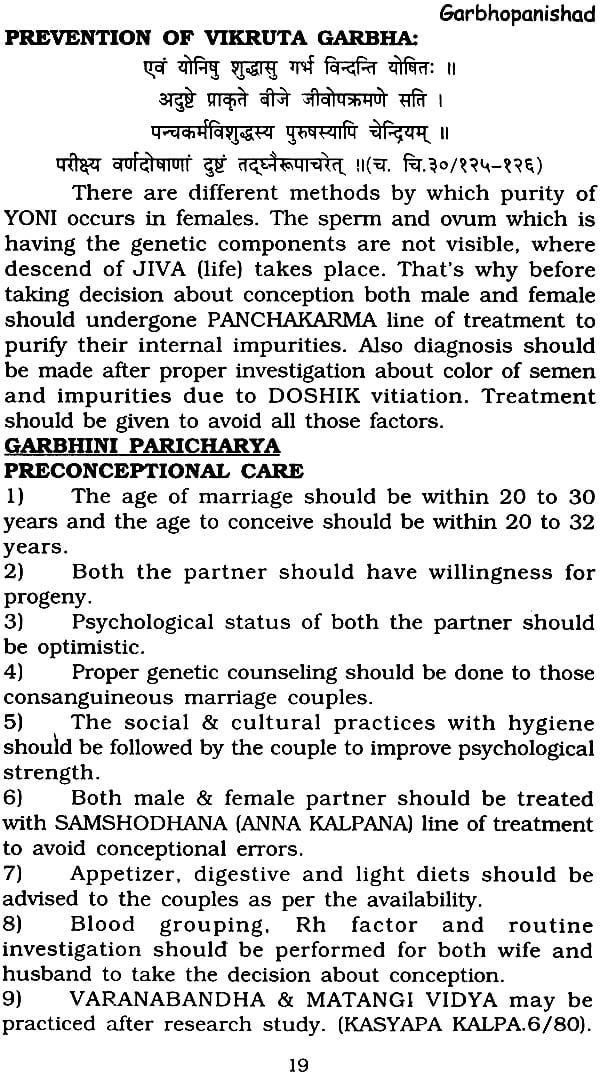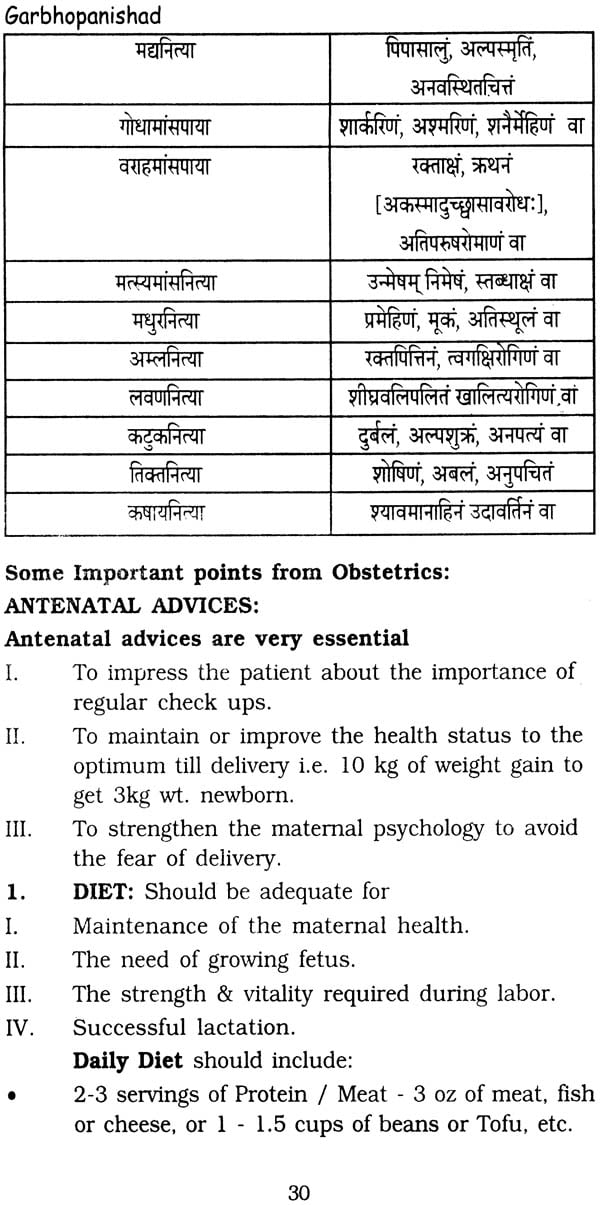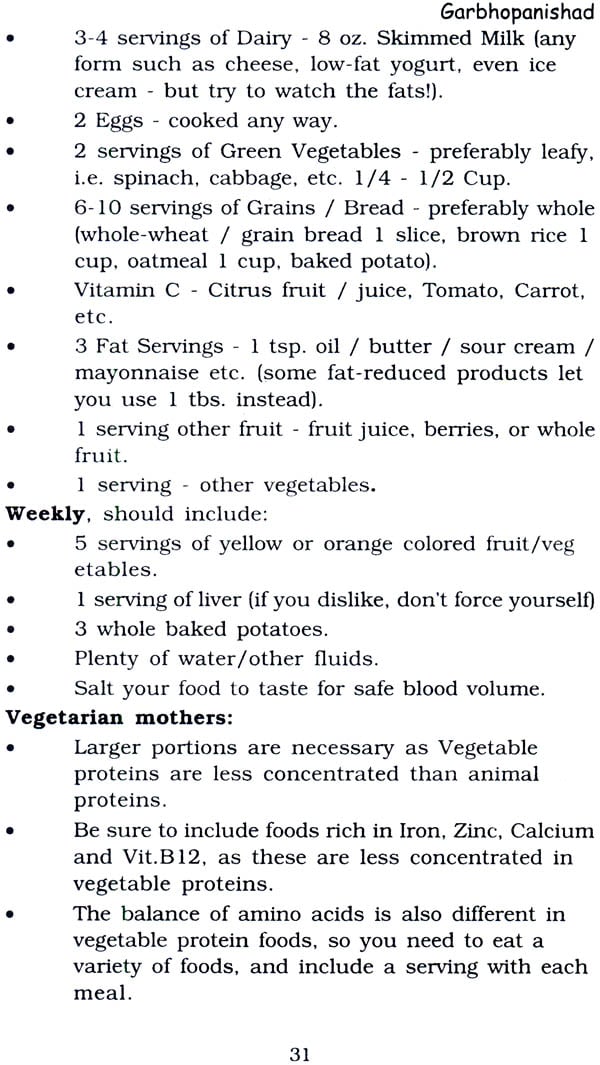
Paippalada's Garbhopanishad (A Brief Treatise on Embryo and Fetus)
Book Specification
| Item Code: | IDJ123 |
| Author: | Durga Prasad Dash |
| Publisher: | CHAUKHAMBHA ORIENTALIA, Delhi |
| Language: | Text with English Translation and Commentary |
| Edition: | 2006 |
| ISBN: | 9788176371476 |
| Pages: | 40 |
| Cover: | Paperback |
| Other Details | 8.3" X 5.3" |
| Weight | 70 gm |
Book Description
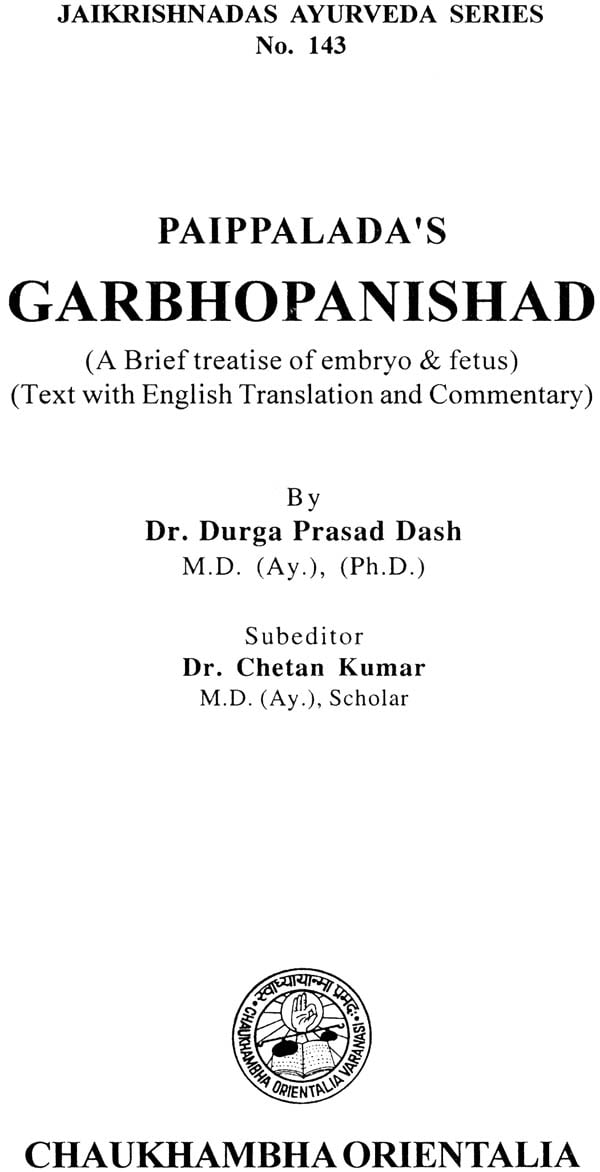
About the Author
Dr. Durga Prasad Dash, Asst. Prof., Department of Post-Graduate Studies in Kaumarabhritya, S.D.M. College of Ayurveda & Hospital is one of the young Ayurvedic Pediatricians. He has been teaching Kaumarabhritya to graduate and Post Graduate Ayurveda scholars since last four years. In February 2005, he had taken Kaumarabhritya classes in CME programme for Doctors of Orissa state, Berhampur Zone as resource person. In November 2005 he was invited as a contributing expert by Rastriya Ayurveda Vidyapith (an autonomous organization under ministry of Health & F.W., Dept. of Ayush, Govt. of India).
He has Co-Guided more than 10 post Graduate dissertations.
Preface
You have a right to perform your duty, but not a right on its reward. Duty be done with an eye on reward, and shun the company of those who shirk duty.
This book aims at explaining ancient 'GARBHAVIJNAANA' might have been written much earlier than the rule of Parikshita i.e. 1416 B.C. (D.N.Bannerjee, Text book of pathology: The medical Bureau; Calcutta-1941). The description pattern of the shlokas of GARBHOPANISHAD is somewhat different in comparison to other texts. There is no end of one science. Inquisitive human tries to search the truth with enthusiasm. The brief description of this book contains valuable Research problems as well as treatment methods for practitioners. Modern Gynecology & Obstetrics develops a lot due to continuous research work done all over the world. Sometimes it makes difficult to understand the Ayurvedic descriptions, as the views are too critical to screen and compare through modern parameters. This book is an effort to create research problems, so that one can able to find out the exact knowledge of prasuti-tantra from different sorts of descriptions.
First of all I would like to express my sincere gratitude to my beloved teachers Prof. C.H.S.Sastry, Prof. B.K.Jaysingh, Prof. C.M. Jain and Prof. R.D.Sharma for their constant guidance to reach this height.
I pay my heartiest gratitude & respect to his Excellency, the holy personality Rev. Dr. D.Veerendra Heggade, Dharmasthala-President SDMES, Ujire for providing me opportunity to continue my work.
I will remiss if I will not pay my humble gratitude to Dr. Prasanna. N.Rao, Principal, S.D.M. College of Ayurveda & Hospital, Hassan, Karnataka, for his constant support and guidance for smooth conduction of my works.
I could not but express about the co-operation given to me by me colleagues Dr. Shailaja U.(Asst. Proffesor) & Dr.Shrinidhi. K. Acharya (Lecturer) of Post-Graduate Department of Kaumarabhritya, Dr. Mallika K.J., H.O.D. Dept of Basic principles and Dr. Kavitha, Dept. of Prasuti-Tantra for their contribution in completing this work.
It's a real fact that I got constant support and cooperation of my colleagues Dr. Ashvini Kumar (Asst. Prof. P.K.), Mr. Chandrasekhar K.L. (Librarian) & P.G. scholars Dr. Chethan kumar V.K., Dr. Sudheer B.R., Dr.Bhavesh, Dr. Abhijit, Mr.Naveen B.S. and others for their timely support.
It is my immense pleasure to introduce this monograph Garbhopanishad, a brief treatise about Garbha which has its origin earlier than 4000 B. C. The contents of these theological treatise are classified under: 1. Vidhi, or the practical directions pertaining to sacrifice; 2, Atharvaveda, or mythological and polemical explanations and 3. Upanishad, or mystical and philosophical speculations on the nature of things.
Among the available descriptions of Prasuti-tantra Garbhopanishad has its own importance as its descriptions are very practical in comparison to contemporary science. This book is an effort to explain the critical subjects in easy language. It is a good reference book for Post graduate students of Prasuti- tantra & Kaumarabhritya Scholars. It will create Research problem for P.G scholars as well as it will help the clinicians for proper management of Prasuti cases. I wish this book all success.
The ancient Indian literatures are broadly categorized into Shruti, Smriti, Dharmagrantha, Purana, Veda. Vedanta. Upanishad etc. The Four Vedic Samhitas. namely Rig. Sama. Yajur and Atharva are in the top among all. Ayurveda. the upaveda of Atharvaveda is considered as the sacred medical science covers treatment formulas for both healthy and unhealthy indivisuals. The Upanishads are considered as Shruti (revelation), while the sutras are all smriti (Tradition). Upanishad. (Upa-ni-shad) literally means" sitting down beside". or an intimate discussion. and. in a broad sense. a brief treatise of a catechistical nature. The base theme of all the Upanishads, expounded in various ways by the Vedic schools, is the nature of Atma (Soul) or Brahma (the supreme Soul), Vishnu (the creator). The Upanishads are composed either in prose. or in verse. or in both. Traditionally there are 1180 different shakhas (branches or schools) of the various Vedas (Rig - 21; Sama - 1000; Yajur - 109; and Atharva -50), each having its own Upanishad, but not many of these are available today. Chronologically, the Upanishads written in prose of Brahmana style, like the Brihdaranyaka, Chhandogya, Taittiriya. Aitareya and Koushataki are the oldest, and the Atharvan Upanishads are the latest, the majority of them belonging to the post-Vedic period.
Change is the nature of science, an inquisitive person always tries to search science in the boundary of his own philosophy. Skill is measured from one's creative thoughts. Hense the true matter can be rearranged in different forms as per the demands of the Era.
The tradition and legands of Ayurveda gives the idea about the dynamic creativities and practical implications of the ancient scholars towards the customs and health science. Mr.Elphinstone say's "Their acquaintance with medicine seems to have been more extensive. Their chemical skill is more striking".
The samhitas, which, according to Indian tradition. were handed down from generation to generation, are collections of prayers and praises embodied in metrical hymns and texts, originally composed earlier than 4000 B. C. The basic difference between the samhita's and Upanishad's are, in samhita title given is based on name of the author, whereas in Upinishad the title given is as per the subject matter and author’s name at the end. In Garbhopanishad 'Paippalada’ mtght be the author's name is been mentioned at the end. . The Upanishads, since they occur at the end of the Brahamanas, are also called the Vedanta, of the end of the Veda.
Since it begins with" Sahana Bhavatu ..." Shanti, even though it colophon specifically mentions that the Upanishad belongs to Paippalada Shakha, one of the most important schools of the Atharva Veda.
The Atharvanopanishads can be classified in four categooreis depending upon the fundamental doctrine developed in them as;
1. Pure Vedanta Upanishads like the Upanishads of the other three Vedas; they remain faithful to the old Vedanta doctrine on the nature of Atma, without laying too much emphasis on its development into Yoga, Sanyasa, Vaishnava or symbolism. The GARBHA Upanishad belongs to this class.
2. Yoga Upanishads, mostly in verse and quite short; these emphasize the attainment of union with Atma through ascetic meditation based on the component parts of the sacred syllable Om.
3. Sannyasa Upanishads, quite short, with admixture of prose and verse; they recomment and describe the life of the religious mendicant (sannyasin) as a practical consequence of the Upanishadic doctrine.
4. Vaishnava and Shaiva Upanishads; these are sectarian in character. and interpret gods like Vishnu (Narayana. Nrsinha) and Shiva (Ishana. Maheshwara Mahadeva) as the personification of Atma.
According to Devi. Paippalada and Mandukeya sages flourished during the reign of Parikshit in Paurava and Shrutavan in Maghadha about 1000 B.C ., and Bannerjee states that Parishit ruled in 1416 B.C. This would place the period of the original composition of the GARBHA Upanishad to a much earlier date than usually assigned to the monor Atharvan Upanishads. as corroborated by Majumdas and Puslakar who state the that "the GARBHA Upanishads may perhaps belog to greater antiquity that the rest"
The name of Paippalada. and at times of Paippalada, as it occurs in the present text published in Ishadivinshatopanishad (120 Upanishads) is also borne by the GARBHA Upanishad. the contents of which differ from all the other Upanishads, and relate to the formation of an embryo from the time of its conception. and to the various parts of the human body. The GARBHA Upanishads is a "commentary on a trishtubh strophe prefixed to it. the words of which are passed interview singly and further remarks then subjoined. The age this Upanishads is quite uncertain. but there seems to be no doubt about the fact that it represents the Atharvana theory of human development as found the works of the Paippalada School.
"Change is the law of life. And those who look only to the past or present are certain to miss the future”.
| 1. | Introduction | 1 |
| 2. | Garbhopanishad | 4 |
| 3. | Panchamahabhuta Physiological Consideration | 4 |
| 4. | Panchamahabhuta Anatomical Consideration | 5 |
| 5. | Vital Physiological Functions | 6 |
| 6. | Six Tastes | 6 |
| 7. | Seven Voice | 6 |
| 8. | Seven Basic Elements | 7 |
| 9. | Function of Fetal Heart | 7 |
| 10. | Fetal Development | 8 |
| 11. | Genetic Consideration | 11 |
| 12. | Development of Psychosomatic Factors | 12 |
| 13. | Fetal Psychology | 13 |
| 14. | Mythology for Salvation | 13 |
| 15. | Mythology How Fetus Forgets Sorrow | 14 |
| 16. | Concept of Agni | 14 |
| 17. | Functions of Karmendriya | 14 |
| 18. | Brief Anatomy | 15 |
| 19. | Role of Panchamahabhuta in the Formation | 17 |
| 20. | Development of Garbha | 17 |
| 21. | Role of Mahabhutas in Embryogenesis | 17 |
| 22. | Vikruta Garbha | 19 |
| 23. | Garbhini Paricharya | 19 |
| 24. | Diet & Regimen | 21 |
| 25. | Masanumasika [Vishesha] Paricharya | 27 |
| Bibliography | 39 |
